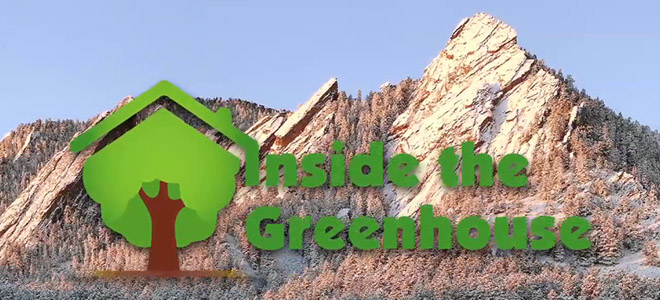NEW PILOT EPISODE for Inside the Greenhouse
About Inside the Greenhouse
Creative framing and storytelling of issues surrounding climate change through video, theatre, dance, and writing can connect a wider audience to the deep and pressing need to address climate change. View Episode
There are four components to the ITG project:
1. a two-course series offered at the University of Colorado
2. twice-a-year public events
3. a 23-minute television program
4. connected activities
The first component is comprised of two complementary parts. First, Professor Rebecca Safran has been teaching ‘Climate and Film’ in the Ecology and Evolutionary Biology department since Fall 2009.
Second, in Spring 2012 the Professors Osnes and Boykoff taught an undergraduate upper division course with the objective of helping a cross-disciplinary group of students to understand, appreciate, and develop narratives or multimodal compositions – through performances, art, weblogs, and films. The interdisciplinary approach drew on each of their capabilities and interests to help students that seek to capture the complexity and dynamism of multi-scale and contemporary climate science, policy and politics. This course will be taught again in Spring 2014.
Together, ITG now offers the two courses that focus on communicating aspects of climate change through a variety of artistic forms including video, performance and writing.
• Climate Change and Film (ATLS 3519/EBIO 4460) offered in Fall semesters by Safran
• Inside the Greenhouse (ENVS 4100) offered in Spring semesters by Boykoff and Osnes
As the second component, in April, 2013 we held a successful pilot event with critically-acclaimed photographer (and star of the recent film ‘Chasing Ice’) James Balog where we attracted 1,500 people to Macky Auditorium on the CU-Boulder campus. The PI and colleagues have reserved Macky Auditorium October 6 and have confirmed participation from members of ‘Climate Wise Women’. By attracting the public to this issue through the celebrity status of our guest, the events provide an opportunity to shine a light on student work that uses creative means to communicate positive solutions to climate change. These events are used to engage a wide variety of area students in effective communication strategies for climate related issues as well as integrate better the coursework and skill set of our climate communication students into a larger public production.
As a third component of the ITG project, we are producing a pilot 23-minute program – incorporating creative climate communications from student projects assembled in our partner courses. The centerpiece of this program draws on part two of the project, recording from an on-stage interview with a high-profile public figure who has been wrestling with questions regarding climate science, policy and the public. As part of this, guests to the live event visit onsite locations in the Boulder community as part of the stories in the program, and as part of the important dimension of outreach beyond campus (e.g. K12 classrooms). The footage taken during these visits will also become part of the programs.
For the fourth component, we connect this work with other associated projects.
ITG is “the interface of climate and society. It melds the arts and environmental studies.” – Andrew Revkin, New York Times
ITG “creates opportunities for new scholarship, research, and creative works that may not happen in the absence of these courses.” – Todd Gleeson, dean of College of Arts and Science, University of Colorado
ITG is “a fitting way to highlight a productive intersection of theatre and environmental science.” – Philanthropist Gordon Gamm
“I think it is so important to have more communication courses in environmental studies, we often do not get to engage hands-on with our mission. I think a lot of environmentalists themselves buy into the culture gap between us and the conservatives, big business, etc. but that true progress is going to be made not by alienating but communicating to everyone in a positive way”. – Student Testimonial, Abrina
“Walking into class on day one, I was expecting to literally go inside a greenhouse. Walking away I now have a totally new understanding of the complexities surrounding climate change and the issues regarding education and action”. – Student Testimonial, Richard
“I think it’s so important to make the connections between climate science and media, because as many people in our class have mentioned, the typical node of communication in the scientific community is by publishing papers or reading research journals. While these are great methods, it’s crucial to have the environmentalists engage in various forms of social and mass media to get their messages out there to the world as a whole”. – Student Testimonial, Keely
“So in a way, this class has really challenged me to look inward and think about what my own motivations are for caring so deeply and passionately about environmental issues, in order to think about the best way to connect with audiences emotionally. This has allowed me to grow personally in ways that I really did not expect this semester, and I am thankful to have some newfound skills and tools for effective communication about important environmental issues in the future”. – Student Testimonial, Brooke
The Inside the Greenhouse course was made possible through generous funding by the Grace and Gordon Gamm Interdisciplinary Fund, the CU-Boulder Outreach and Engagement Program, and the Arts and Sciences Support of Education through Technology (ASSETT) program. Learn more …


